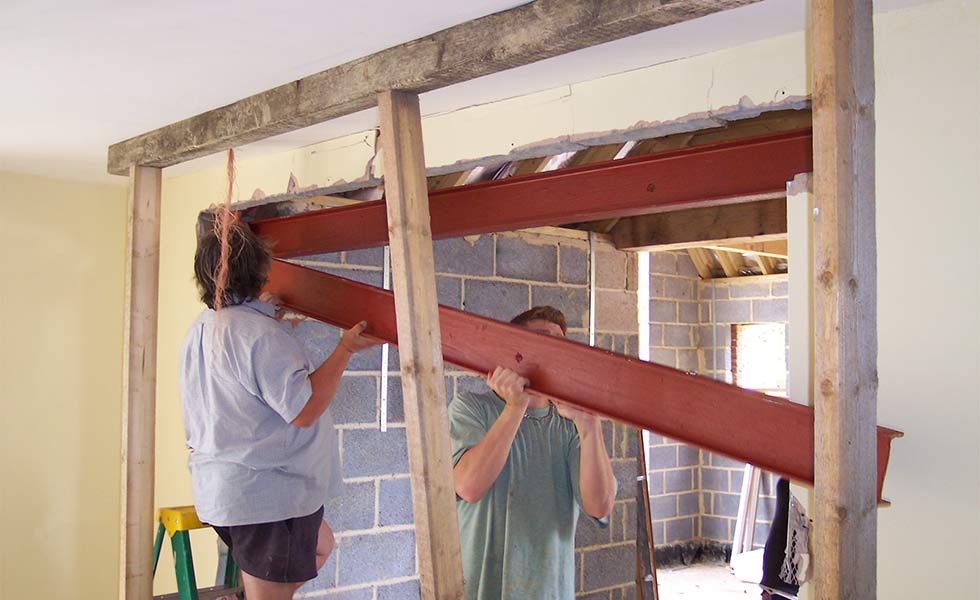How Long It Takes To Renovate Every Single Room In Your House
Contractors get a bad rap for not finishing projects in a timely fashion. When you have dust on everything and strangers in your home, it can certainly feel like an eternity. But maintaining sanity during a remodel—both yours, and your contractor’s—requires an awareness of how long it takes for a house renovation. It takes a long time!
“A good contractor builds you a schedule and says, ‘This is the start date, and this is what’s going to happen over the next several weeks. Demo starts on this date, and so on,'” says Diane Welhouse, CKBR, Executive Director of the Milwaukee Chapter of the National Association of the Remodeling Industry (NARI). “A lot of it comes down to communication, and homeowners need to understand that when they’re embarking on a remodel that’s major in scope, like a kitchen, bath, or addition, their home is going to be disturbed for four weeks or maybe closer to 16 weeks.”
Know up front that delays are common and, especially for large projects like a room addition or an entirely new kitchen, there will probably be days when not much happens because the contractor is waiting for an inspection, products, or subcontractors. Most contractors anticipate delays or time spent waiting, and build those days into the schedule.
Here are a few more things that might cause delays: products being on backorder, like kitchen cabinets or a certain tile that’s out of stock, which prevents them being delivered on time; subcontractors running behind schedule, such as electrician who’s working on another project; bad weather, which can affect outdoor projects like building a deck, constructing an addition, or installing a new roof; unexpected problems, like mold or rotting wood inside the walls, which can’t be detected until the demolition starts; homeowners not choosing materials on time, which delays ordering and then delivery schedules.
How Long Each Room Takes
Many variables can affect timelines, most notably the scope of the project and the size of the work crew. That’s why a bathroom remodel with new cabinets and fixtures might take three weeks, while one where you get new tile and a heated floor might take several months.
“The process of remodeling isn’t just tearing out the old and putting in the new,” says Louis M. Weiher, CR, CCP, president, owner, and general manager of Carmel Builders, Inc., in Menomonee Falls, Wis. “Homeowners need to realize, and often don’t, that the remodeling process doesn’t start with demo. It starts the moment you hire a designer or design-build firm and begin designing your project.”
Here’s an overview of how long remodels typically take once the on-site work kicks off:

JOHNNY VALIANT
An addition is typically the longest project to complete. The upside is that you’ll theoretically still have a functioning kitchen and bathroom during the remodel—a luxury you don’t have with other projects. It’s the same process as building a new home, just on a smaller scale. Delays can be caused by Mother Nature. “You can be at the mercy of the weather,” Welhouse notes. “You might also have issues with products being delivered or pouring concrete or framing if it’s significantly cold.”

VICTORIA PEARSON
Changing the layout, like where the stove, fridge, and sink are located, add to the timeframe, as these updates could entail running new plumbing pipes, installing new electric outlets, and maybe adding a new gas line. “Rooms have to be measured for custom cabinets, and it can be a two to four week wait to get those in,” Welhouse explains. “For high-end countertops, if you want a quality job, you want your base cabinets installed, then countertops are measured with a laser. It takes time to get the countertops cut to size. No wall is ever square, and the laser measures every indentation or imperfection so when the countertops are installed, they fit seamlessly with no gaps.”

ROGER DAVIES
Tile is common in bathrooms, which can eat up a lot of time and prevent others from working in the room at the same time. “Tiling can be a long process,” Welhouse says. “There can be custom niches and different types of tile being used. This can take a couple of weeks because each piece might have to be custom measured and cut. Then once the tile is in, you have to grout it and let it dry.” She notes that custom glass shower doors, which are popular, also take extra time because the doors cannot be measured and ordered until the tub and walls are installed.

HOUSE BEAUTIFUL
Finishing a basement adds to your living space without the expense of building an addition. The time and cost are largely dependent on how finished the basement was already—if interior walls were framed and a bathroom was roughed in—and what you want to do with the space. “If the builder had one vision and you have another on how you want to utilize the space, like moving the bathroom, it’s going to add extra time in the process,” Welhouse says.

KARYN R. MILLET
A crew of three or four people can complete a deck in a week. Adding stairs, multi-level or wrap-around decks, having a built-in whirlpool, and attaching the deck to a house that doesn’t already have a ledger board can add to the timeline.

SIMON WATSON
Even large homes can have a new asphalt-shingled roof installed in a couple days. Other roof materials will take longer.
The Timeline of Any Renovation
No matter which room or area you’re working on, and no matter how much you’re changing, the process and timeline of events remains basically the same. Take a look at this overview to get a sense of what you’re in for.
- Have a price and a plan. You need a good understanding of what you want the remodel to accomplish. Updated look? Increased functionality? Take your ideas—and inspiration photos from magazines or the internet—to an architect, designer, or general contractor to turn your wants and needs into blueprints. And have a realistic budget in mind of how much you’re prepared to spend on the project.
- Hire the right contractor. A successful outcome starts with picking a qualified contractor. Talk to friends and neighbors to get recommendations, then hire one who’s established, has a good reputation, specializes in the type of project you’re undertaking, and you feel comfortable inviting into your home every day.
- Sign a contract. The document should cover all aspects of the job, including payment schedules, products being used, approximate start and finish dates, description of the project, and procedures for change orders. If you have specific rules you want followed, like work not starting before 8:00 AM or workers not using your bathroom, make sure it’s in the contract.
- Pull a permit and prep the site. Most professional remodeling jobs require a building permit, which must be secured before the work starts. Lumber, materials, and a dumpster may show up in your driveway, which is a sure sign the work is about to start. This is your cue to get the room ready, like getting all the dishes, pots, and pans out of the kitchen for a kitchen upgrade.
- Rip out the old. The first step of the actual remodel is demolition. Anything being replaced is ripped out, like old countertops, cabinets, bathtubs, or even walls. For complete overhauls, the room is typically “stripped down to the studs,” which means everything in the room, including the wall covering, is torn out. What remains is the framing, or studs, and what’s inside the walls, like plumbing pipes and electrical cable.
- Frame the new. For a room addition or deck, trenches or holes are dug, then the footings or foundations are added by pouring concrete. Any new rooms, walls, or additions are framed. During this stage, you’ll see big changes in your home as the remodel takes shape.
- Run any new mechanicals. This is when the plumbers come in to run new pipes for a sink, bath, or refrigerator, and install a gas line for the range or outdoor kitchen. Electricians run cable for new fixtures or outlets, and heating and air condition specialists install new vents and registers. At this point, you won’t see much dramatic daily progress.
- Cover the walls. Once the mechanicals have passed inspection, and outer walls are properly insulated, the next step depends on the project. For bathrooms, say, the tub is installed next. For all other projects, the walls are covered with drywall or another material. Then cabinets and countertops are installed.
- Fill out the room. This is when the room comes together, with the flooring, trim, and any wall tile being installed. Once you see the flooring go in, you’re close to the end.
- Add the finishing touches. Walls are painted or wallpapered, plumbing and electrical fixtures like faucets and light switch covers are installed, and register covers are put in place. Any debris is removed and the site is cleaned up.

About the author